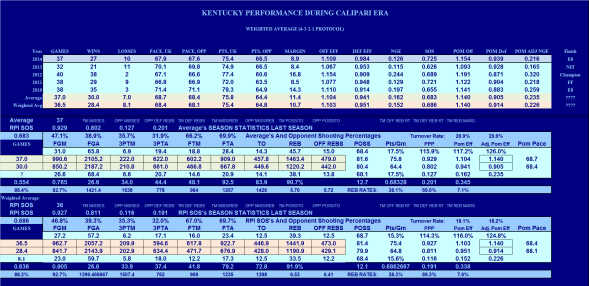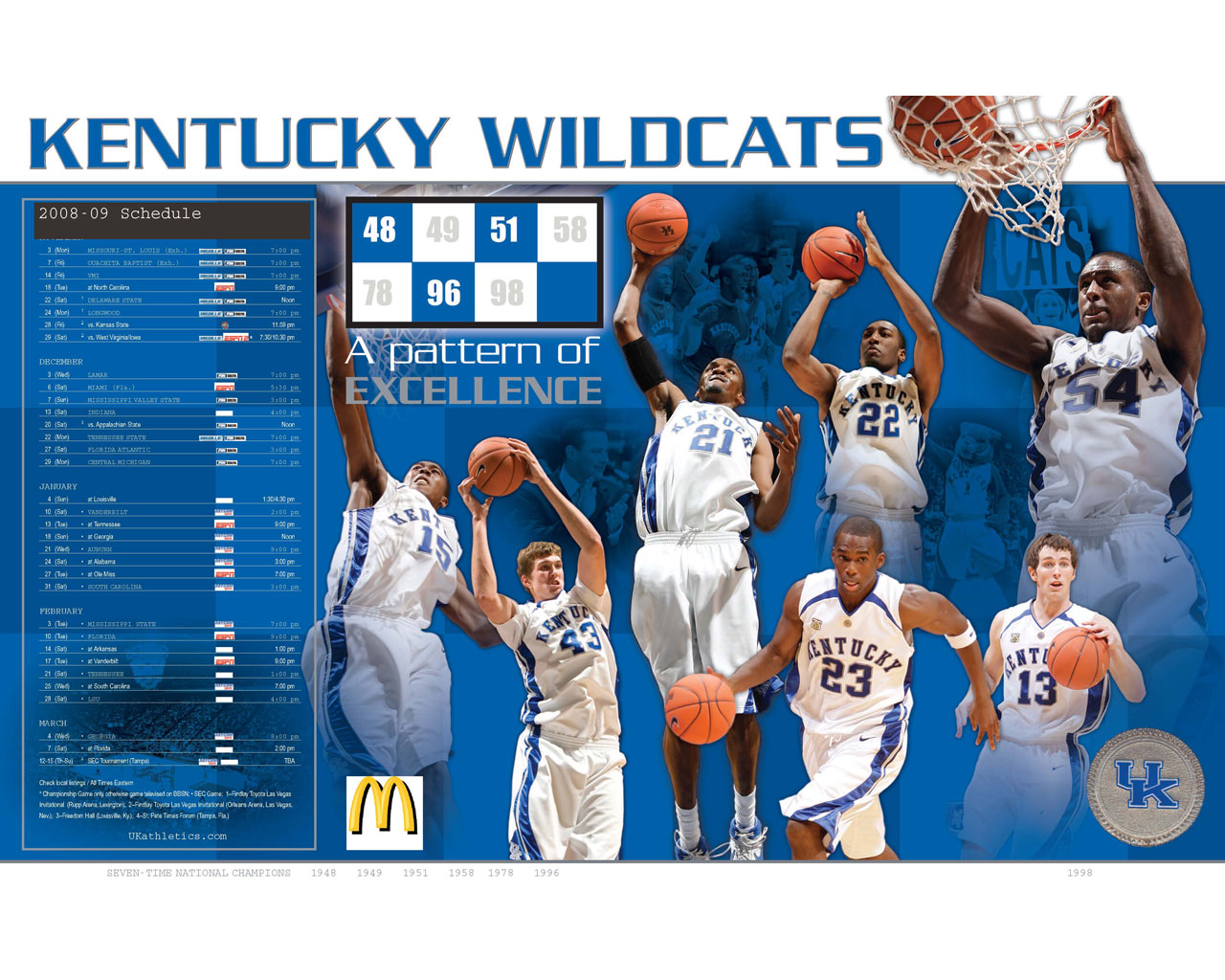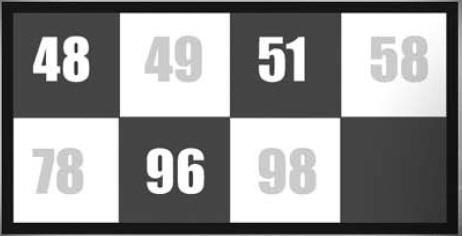BIG BLUE FANS FOR

BASKETBALL
2012-13 Season Analytical Writings
00
Que Sera Sera
(Whatever Will Be, Will Be)
The future's not ours to see.
We all know the message, and the tune is probably rumbling through your mind as you begin to read this piece. You are probably wondering what is the point, and where is he going with this today. Well, we can all agree that whatever will be, will be; that IS why they play the games, right?
The Calipari Era is preparing for its fifth season. The new players will be arriving on campus. Frankly, the expectations have probably never been wilder, or even higher, e.g. Best Recruiting Class Ever! 40-0 is Definitely In Play! Number 9 Is All But Won! Just ship the Trophy now!
Gee, I think I have heard those things before. The Davis-Gilchrist group was also tagged “The Best Class Ever?” We hear talk of undefeated seasons every summer. The Big Blue Nation believed #8 would come “this year”, and now some are counting on #9 even before the kids ever lace up a UK sneaker and put on their wildcat game colors? I think we can all reflect on the last 4 summers and recall hearing those things, that we can all recall at least one fan who uttered those words. Granted, the utterances were more prevalent during 2011 than 2010 or 2011. But, I am hearing more of this talk this summer that even 2 years ago. How about you?
Nevertheless, the future's not ours to see, or is it? Well, let's not get too far ahead of ourselves. North Carolina, Michigan State, Kansas, and Louisville believe they each have something to say about who will be left standing next April. I concede this point, but I make no attempt here to assess the chances of any of these teams. My only concern is what I should reasonably expect from the next group of Wildcats.
I believe that most reliable way to peer into the future is to study the past. The events of the Gillipsie Era certainly have no application to what may occur in year 5 of the Calipari Era. What happened in the Smith era is similarly irrelevant to what may occur in 2013-14. Even the highly successful Pitino Era is not relevant to the forecast for next year. How far back into the Calipari Era remains relevant today?
Each of his first four teams have been new teams, assembled for a single season. Yes, the 2010 team included several “seasoned” holdovers from Billy Clyde's farewell tour. Yes, the 2012 team included Miller, Jones and Lamb from the 2011 Final Four team. Last year's team, and the 2011 team were both substantially rebuilds after heavy NBA draft losses from the previous teams. Even though this season's roster will include Wiltjer, Poythree, Polson, and Hood from the 2013 crew, the 2013-14 Wildcats will again be a rebuilding effort for Calipari's fifth straight season.
In the past, the best indicator for the “next” team was probably the “last” team, because such a high percentage of players from the last team formed a nucleus for the next. The record two years removed was probably not nearly as relevant as the record the last team established, and similarly, the significance drops further looking back three years, and even more with any attempt to look back four year. It is difficult to argue that even with the same coach, a team's record, five years or more removed, has any current relevancy for a forecast of the next team.
With the Calipari Era, UK is breaking new ground. The fifth consecutive “rebuild.” Yes, this team does have some carryover from last year, but the most significant factor for this new team will be how these new players respond to the environment, to the college game, and to Coach Calipari's coaching methods and style. Since all four of Calipari's prior teams had to provide answers to these key questions, and their answers are memorialized by the records they produced, in looking forward, it is at least arguable that the response of the 2010 roster to the challenge is as relevant today as the 2013 roster's response to the same set of challenges.
The detractors, the naysayers, want to point only to last year's results and assign so much weight to that result as to render the prior 3 season outcomes irrelevant in their attempt to argue that the Cats' 2013-14 outlook is full of doubt. They use this same argument to argue that Calipari's 2011-12 team simply caught lightning in the bottle, and the championship is the aberration within this history. Wildcat fans take the opposite view about aberrations, and argue that last year's results should be ignored in looking ahead to this next team.
I do not believe that either extreme approach provides the clearest reading of that crystal ball. The use of a weighting system for the four prior seasons (the traditional approach) or give each of these prior seasons equal standing (the Calipari Rebuild Theory approach) produce almost identical statements about what Calipari's next team would look like IF it achieves an average outcome in 2014. Therefore, it is not necessary to resolve the question of weighted v. arithmetic averages this year. Further, since the Calipari record only has four prior years, it is not necessary to resolve the question of whether future forecasts should only look 4 years back, or whether all of Calipari's rebuilds at UK have equal value.

The table above provides the results of the last four seasons, and computes an arithmetic average and a weighted average. As you can see, there is very little difference between them, but the arithmetic average does yield a slightly stronger average team. The best analysis available today for the 2014 season is that this team has a 50% probability of performing above this average level of play, and a 50% probability of playing below the average. Take you pick.
At the average level of play, this team will go through the 13 game non-conference schedule next November and December with 9 solid wins by predicted margins of 9 to 29 points. Four games will determine whether this team is above or below average:
At North Carolina -2 Pts
Michigan State in Chicago -1/2 Pts
Louisville ½ Pts
Baylor at Cowboys Stadium 3 1//2 Pts
Strictly by the numbers, 2-2 in these four games, with 3-1 easily within reach, and 4-0 at least still in the discussion.
In the SEC, assuming the schedule maker keeps the same home-away matchups for the coming season, and flips the single game opponent venues, then the Cats will be favored to win 15 and lose 3. However, that forecast is based on the SEC opponents coming back in 2014 with the same quality of play as they ended 2013. In the aggregate, that assumption may provide a useful early glimpse, but the team by team analysis would suggest that Florida is not likely to repeat the quality of play they posted last year, and Florida provides 2 of the 3 underdog games, which I find hard to believe. The team that could rise to threaten the Cats for a third SEC loss might be Texas A&M. Time will tell, of course, but at this point I foresee a high probability that the Cats will move through the SEC at 15-3, and end as regular season champions.
That is 26-5 regular season, with a 50% probability. Of course, my expectations are on the “better than average” outcome than the “below average outcome” If they do get through the season at average or better, I will like the Cats' chances in the post season, and then it is about putting it all together for that tournament run.
Oh, when will Big Blue Madness happen this year?
Submitted by Richard Cheeks


Submitted by Richard Cheeks
![]()
To Who Are The Top Programs Heading Into the new Season?
Copyright 2013
SugarHill Communications of Kentucky
All Rights Reserved